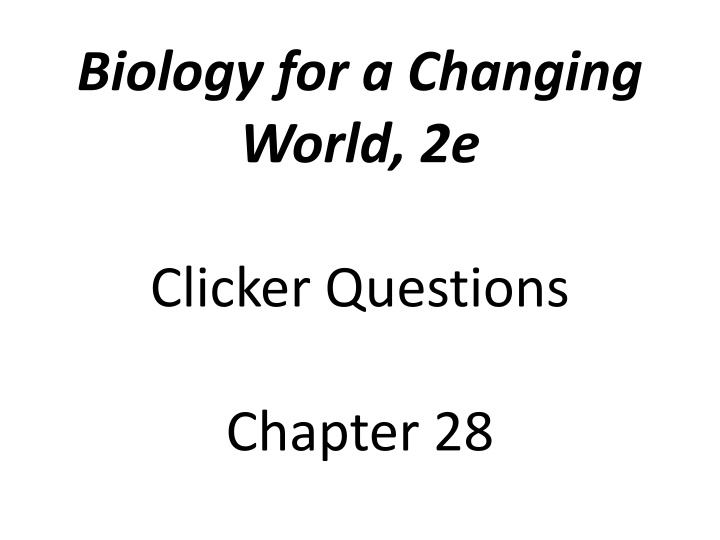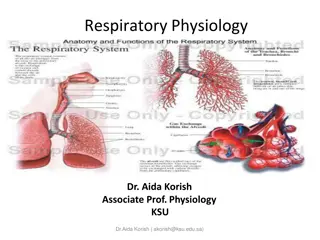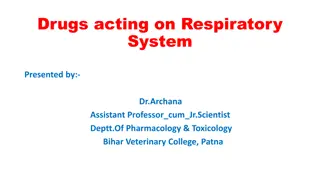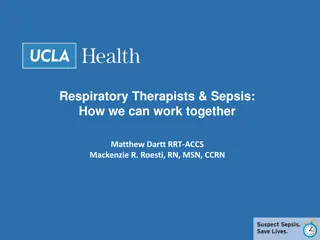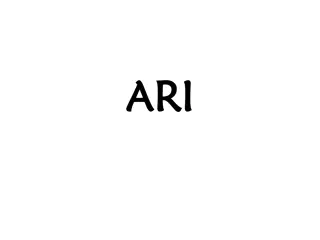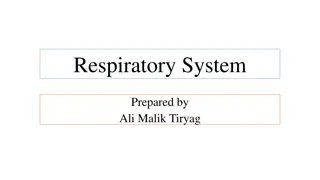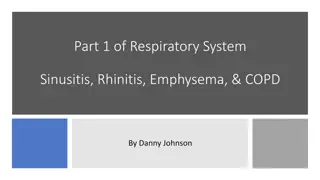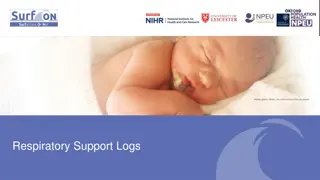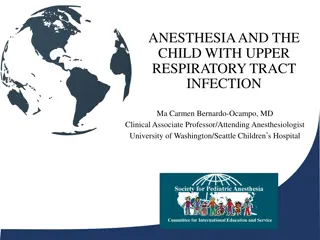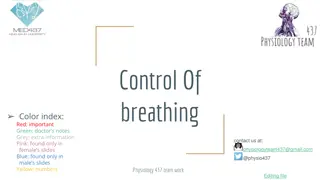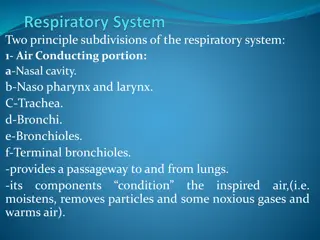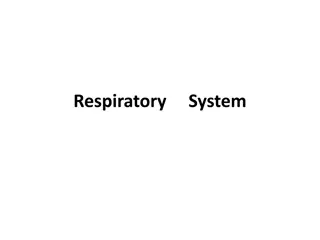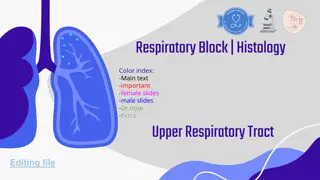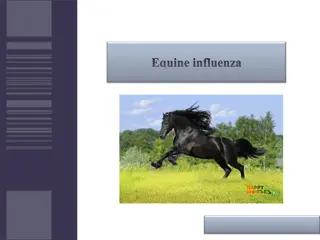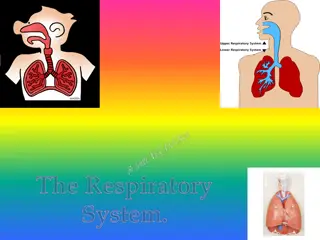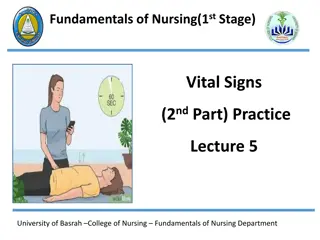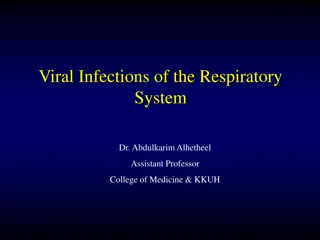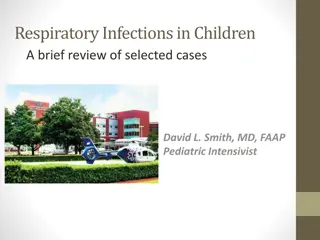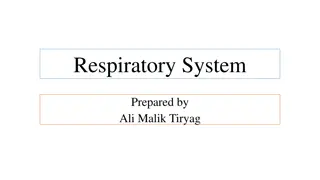Respiratory System Questions and Answers
Explore a series of clicker questions related to the respiratory system: from the pathway of inhaled air to the mechanisms of gas exchange in the alveoli. Understand concepts like inhalation, exhalation, respiratory surfaces, diseases like emphysema, and oxygen transport in the body.
Download Presentation

Please find below an Image/Link to download the presentation.
The content on the website is provided AS IS for your information and personal use only. It may not be sold, licensed, or shared on other websites without obtaining consent from the author.If you encounter any issues during the download, it is possible that the publisher has removed the file from their server.
You are allowed to download the files provided on this website for personal or commercial use, subject to the condition that they are used lawfully. All files are the property of their respective owners.
The content on the website is provided AS IS for your information and personal use only. It may not be sold, licensed, or shared on other websites without obtaining consent from the author.
E N D
Presentation Transcript
Biology for a Changing World, 2e Clicker Questions Chapter 28
What pathway does inhaled air take from the nose to the lungs? A. Pharynx, larynx, trachea, bronchi, alveoli B. Alveoli, bronchi, trachea, larynx, pharynx C. Pharynx, trachea, larynx, bronchi, alveoli D. Larynx, pharynx, trachea, alveoli, bronchi E. Alveoli, bronchi, trachea, pharynx, larynx
When the ______ relaxes, exhalation occurs. A. Bronchus B. Trachea C. Alveolus D. Diaphragm E. Lung
Which of the following is true during inhalation? A. The volume of the chest cavity increases. B. The pressure within the chest cavity decreases. C. The pressure within the chest cavity increases. D. A & B E. A & C
Humans use lungs as a respiratory surface. Insects use a different system called ____. A. Gills B. A breathing tube C. A tracheal system D. Respiratory hairs E. All of the above except A
Emphysema is a disease that causes alveolar walls to burst. This affects the respiratory system by A. reducing the surface area for gas exchange. B. reversing the direction that carbon dioxide diffuses. C. decreasing the amount of oxygen absorbed. D. All of the above E. A & C
How does oxygen move from the alveoli to body cells? A. Active transport moves oxygen into capillaries B. Oxygen diffuses into capillaries C. Hemoglobin uses active transport to pull oxygen into red blood cells D. Both A & C E. Both B & C
Why is the term cardiorespiratory system sometimes used to describe the cardiovascular and respiratory systems? A. People used to think the two systems were the same. B. These systems provide gas exchange for tissues by working together. C. These systems are in close proximity to each other. D. Athletic trainers coined the term to make it easier to describe the two systems. E. All of the above.
Which of the following would cause oxygen to be delivered to tissues at a faster rate? A. Increasing body temperature B. Decreasing the partial pressure of oxygen in the lungs C. Decreasing the number of red blood cells in circulation D. Increasing the amount of carbon dioxide in the blood E. Decreasing the amount of hemoglobin within red blood cells.
The concentration of carbon dioxide in your blood ____ when you exercise and your blood pH ___. A. Increases; decreases B. Increases; increases C. Decreases; decreases D. Decreases; increases E. pH is not affected by carbon dioxide levels
Iron is required in our bodies because A. Iron affects oxygen-carrying capacity. B. Iron is part of hemoglobin. C. Iron is used to break down carbon dioxide. D. All of the above. E. A & B only.
Altitude sickness is caused by A. Having too many red blood cells. B. A genetic disorder that affects hemoglobin. C. Moving rapidly to a lower altitude. D. Moving rapidly to an altitude with a lower partial pressure of oxygen. E. Kidney disease affecting the release of erythropoietin.
When carbon dioxide levels in the blood increase, the respiratory system responds in which of the following ways? A. Breathing rate decreases B. More capillaries develop around alveoli C. Breathing rate increases D. Alveolar walls burst E. Oxygen begins to be actively transported into capillaries
Which of the following would lead to an increase in breathing rate? A. A decrease in carbon dioxide in blood B. A decrease in oxygen in blood C. A decrease in blood pH D. An increase in carbon dioxide in blood E. Both C & D
A physiological change during exercise that would cause hemoglobin to release more oxygen at tissues would be A. An increase in temperature B. An increase in blood pH C. An increase in oxygen in blood D. A decrease in temperature E. An increase in iron in blood
Which of the following is true of high altitudes in comparison to sea level? A. More red blood cells are produced. B. The partial pressure of oxygen is lower. C. The air pressure is lower. D. There are fewer oxygen molecules available. E. All of the above.
Why do some athletes use hypoxic chambers? A. Hypoxic chambers mimic low-oxygen environments and stimulate the production of red blood cells. B. They are inexpensive. C. Hypoxic chambers work faster than training at high altitudes. D. Hypoxic chambers have been shown to increase muscle mass. E. All of the above.
Which of the following hormones might be used by athletes as a way to increase the percentage of red blood cells in their blood? A. Insulin B. Glucagon C. Somatostatin D. Testosterone E. Erythropoietin
Why is it difficult to determine whether an athlete has used erythropoietin (EPO) for blood doping? A. EPO is a complex molecule that can be difficult to detect with current tests B. EPO is a natural hormone present in everyone C. EPO is only found for very brief periods during the day D. Athletes frequently refuse to give blood for tests E. All of the above
Which of the following statements is not true regarding erythropoietin (EPO)? A. EPO is primarily released from bone marrow. B. EPO stimulates the production of red blood cells. C. EPO is a hormone released in response to a decrease in oxygen-carrying capacity. D. Misuse of EPO may lead to an increased risk of stroke. E. All of the above are true.
How would increasing an athletes maximum oxygen uptake be beneficial? A. They would have lower carbon dioxide levels. B. Their blood pH would decrease. C. They would have a lower risk of stroke. D. They would have an increased aerobic respiration capacity. E. All of the above.
